
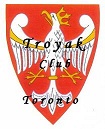
“TROYAK” CLUB NEXT MEETING …
NASTĘPNE SPOTKANIE KLUBU “TROYAK”
TROYAK CLUB @ Roncesvalles Polish Festival 2019
https://polishfestival.ca www.kazimierz.org
Saturday, September 14th, 2019 … Festival Hours: 11:00am to 11:00pm
Sunday, September 15th, 2019 … Festival Hours: 11:00am to 7:00pm
St. Casimir’s Church
Parish Hall … 156 Roncesvalles Ave. Toronto, Ontario
Stamp Exhibit … Pope John Paul II on World Stamps and
Displays of Coins, Stamps, Collectibles by Troyak Club Members.

The 2019 Roncesvalles Polish Festival, North America’s largest celebration of Polish culture in Toronto’s best neighbourhood, Roncesvalles Village! will be taking place on September 14th and 15th, 2019. Now entering its fourteenth year, the Festival adds an old-world charm to today’s Roncesvalles Village, well-known as one of Toronto’s most vibrant, diverse and creative communities. Enjoy great local and international music, including Polish folklore, Polka and Euro dance bands, and entertainment from near and far on multiple stages. Saturday night enjoy the ever-popular Disco Polo Party. Come out and sample fantastic cuisine from over 40 renowned restaurants, cafes, bakeries, and bistros, along Roncesvalles, and of course, lots of traditional Polish fare, including pierogi, kielbasa, bigos, cabbage rolls, and much much more!
Discover treasures along the 18 blocks of boutique shops and merchants. We also have a Car Show and many great vendors with unique products and food. The Roncesvalles Polish Festival is easy to get to by transit and car, family-friendly and free, with lots of entertainment for kids, families, and adults, including two midway areas, three stages with continuous entertainment, two giant beverage gardens, and of course the wonderful offerings of Roncesvalles Village’s restaurants and merchants. Find out what over 300,000 people discovered last year: nobody knows how to party quite like us! See you at the Roncesvalles Polish Festival!

TROYAK EXECUTIVE TEAM is informing all members, colleagues, collectors and Polonia at large, that Club meetings taking place at John Paul II Polish Cultural Centre, 4300 Cawthra Rd. (just south of Hwy. 403), Mississauga, Ontario. The new members are always welcome. www.polishculturalcentre.ca
ADRES SPOTKAÑ KLUBOWYCH ! Zarząd Główny Klubu “Troyak” informuje wszystkich członków kolekcjonerów, sympatyków oraz całą Polonię, że spotkania klubowe odbywają się w Polskim Centrum Kultury im. Jana Pawła II, przy 4300 Cawthra Rd. (na południe od autostrady 403), Mississauga, Ontario. Zapraszamy nowych członków do prężnego. Klubu “Troyak”. www.polishculturalcentre.ca

“TROYAK” CLUB NEXT MEETINGS …
NASTĘPNE SPOTKANIA KLUBU “TROYAK” …
29th September 2019 @ 4:30 p.m.
6th October 2019 @ 9:00 a.m. to 4:00 p.m. …
Mississauga’s Coin & Stamp Show 2019
27th October 2019; 24th November 2019
December 2019 @ Happy Holidays !
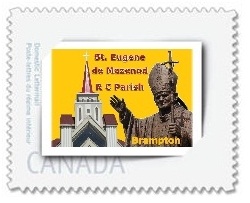
12th January 2020 @ 4:30 p.m. … Annual General Meeting
26th January 2020; 23rd February 2020
8th March 2020 …
XVII Polish – Canadian Coin, Stamp & Collectibles Show 2020
29th March 2020 @ 4:30 p.m.
26th April 2020; 31st May 2020; 21st June 2020

400-lecie Zamku Królewskiego w Warszawie
The 400th anniversary of the Royal Castle in Warsaw
www.poczta-polska.pl
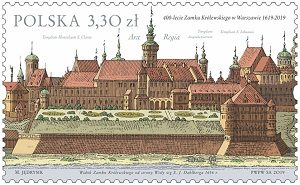
W dniu 29 maja 2019 r. został wprowadzony do obiegu znaczek pocztowy o wartości 3,30 zł emisji “400-lecie Zamku Królewskiego w Warszawie”. Na znaczku przedstawiono widok Zamku Królewskiego w Warszawie od strony Wisły według rysunku E. J. Dahlberga z 1656 roku. Na kopercie FDC przedstawiono fragment Rolki sztokholmskiej z kolekcji Zamku Królewskiego w Warszawie. Znaczek wydrukowano techniką offsetową, na papierze fluorescencyjnym, w formacie: 51 x 31,25 mm , w nakładzie 216 000 sztuk. Arkusz zawiera 12 znaczków. Z tej okazji została wydana również koperta FDC. Autor projektu znaczka: Maciej Jędrysik.

The 400th anniversary of the Royal Castle in Warsaw…
denomination: 3,30 PLN; number of stamps in set: 1;
print run: 216.000 pcs.; printing techniques: offset;
paper: fluorescent; stamp size: 51 x 31,25 mm;
12 stamps in sheet; number of FDC: 1; author: Maciej Jędrysik;
circulation date: 29th May 2019.

Polscy architekci w Azerbejdżanie
Polish Architects in Azerbaijan
www.poczta-polska.pl

Wartość: 3,30 zł … autor projektu znaczka: Maciej Jędrysik;
liczba znaczków: 8; nakład: 160 000 szt. Każdego;
technika druku: offset; format znaczka: 51 x 39,5 mm;
papier: fluorescencyjny; arkusz sprzedażny: 8 znaczków;
data wprowadzenia do obiegu: 31 maja 2019 r.

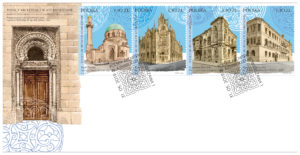
Polish Architects in Azerbaijan … denomination: 3,30 PLN;
number of stamps in set: 1; print run: 160.000 pcs.;
printing techniques: offset; paper: fluorescent;
stamp size: 51 x 39,5 mm; 8 stamps in block;
circulation date: 31st May 2019; number of FDC: 1;
author: Maciej Jędrysik.

40 Rocznica I pielgrzymki papieża Jana Pawła II do Polski
40th Anniversary of Pope John Paul II’s First Pilgrimage to Poland
www.poczta-polska.pl
W dniu 02 czerwca 2019 r. został wprowadzony do obiegu znaczek pocztowy w bloku o wartości 8,40 zł emisji “40. rocznica I pielgrzymki papieża Jana Pawła II do Polski”. Na znaczku przedstawiono zdjęcie portretowe papieża Jana Pawła II; wzdłuż lewej krawędzi znaczka umieszczono napis: POLSKA i oznaczenie wartości 8,40 zł. Na oprawie bloku, wzdłuż lewej krawędzi – umieszczono nazwę emisji: ,,40. rocznica I pielgrzymki papieża Jana Pawła II do Polski”, a wzdłuż górnej krawędzi – cytat ,, Niech zstąpi Duch Twój! Niech zstąpi Duch Twój i odnowi oblicze ziemi. Tej Ziemi.” Znaczki wydrukowano techniką offsetową, na papierze fluorescencyjnym, w formacie znaczka 31,25×43 mm, format bloku 90×70 mm, w nakładzie 100.000 sztuk. Z tej okazji została wydana koperta FDC. Autor projektu: Jerzy Pietras. Autor koloryzacji fotografii: Mirosław Szponar.
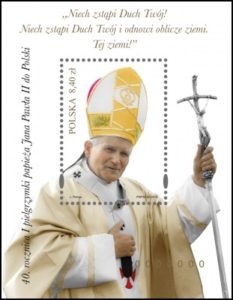
40th Anniversary of Pope John Paul II’s First Pilgrimage to Poland …
denomination: 8,40 PLN; number of stamps in set: 1 in block;
print run: 100.000 pcs.; printing techniques: offset; paper: fluorescent;
stamp size: 31,25 x 39,5 mm, block size: 70 x 90 mm; number of FDC: 1;
circulation date: 02nd June 2019; author: Jerzy Pietras;
author of the photographic colouring: Mirosław Szponar.
Wizerunek Jana Pawła II znalazł się na okolicznościowym znaczku Poczty Polskiej wyemitowanym w związku z 40. rocznicą pielgrzymki Papieża do Polski. Znaczek w nakładzie 100 tys. sztuk trafi do obiegu 2 czerwca br. Jerzy Pietras, autor znaczka wykorzystał zdjęcie, jakie 2 czerwca 1979 roku zostało zrobione na pl. Zwycięstwa (dziś placu Piłsudskiego) w Warszawie. Wzdłuż górnej krawędzi znaczka umieścił cytat z wypowiedzi papieża: „Niech zstąpi Duch Twój! Niech zstąpi Duch Twój i odnowi oblicze ziemi. Tej Ziemi.” Słowa te stały się jednym z pierwszych haseł powstałej rok później „Solidarności”.

Podczas dziewięciodniowej pielgrzymki, Jan Paweł II odwiedził Warszawę, Gniezno, Częstochowę, Kraków, Kalwarię Zebrzydowską, Wadowice, Oświęcim i Nowy Targ. Oprócz znaczka, Poczta Polska wyemitowała kopertę pierwszego dnia obiegu, na której umieszczone jest zdjęcie wiernych zgromadzonych na pl. Zwycięstwa. Poniżej znajduje się herb papieski oraz podpis: I pielgrzymka papieża Jana Pawła II do Polski; Gaude Mater Polonia, 2–10.06.1979
Poczta Polska wielokrotnie upamiętniała papieskie pielgrzymki do ojczyzny, jubileusze powołania na Stolicę Piotrową, rocznice urodzin, wydarzenia związane z życiem i posługą Świętego Jana Pawła II. W październiku ub. roku do obiegu trafił znaczek z okazji 40. rocznicy wyboru kardynała Karola Wojtyły na papieża.

4 czerwca 1989 r. 30. Rocznica odrodzenia Senatu i wolnych wyborów
4 June 1989, 30th Anniversary of the revival of the Senate and free elections
www.poczta-polska.pl
W dniu 04 czerwca 2019 r. został wprowadzony do obiegu znaczek pocztowy o wartości 5,00 zł emisji “4 czerwca 1989 r. 30.rocznica odrodzenia Senatu i wolnych wyborów”. Na znaczku przedstawiono laskę marszałkowską wykonaną i podarowaną Senatowi RP w 1991 roku przez Cech Rzemiosł Artystycznych z Warszawy z okazji 200. rocznicy uchwalenia Konstytucji 3 maja; w lewym górnym rogu znaczka umieszczono oznaczenie wartości 5 zł oraz napis Polska, a wzdłuż prawej krawędzi – temat emisji: ,,4 czerwca 1989 r. 30. rocznica odrodzenia Senatu i wolnych wyborów”. Znaczek wydrukowano techniką offsetową, na papierze fluorescencyjnym, w formacie: 31,25 x 76,5 mm, w nakładzie 120 000 sztuk. Arkusz zawiera 6 znaczków. Z tej okazji została wydana również koperta FDC. Na kopercie widnieje herb Senatu RP oraz podpis: 4 czerwca 1989 r. 30. rocznica odrodzenia Senatu i wolnych wyborów. Autor projektu znaczka: Andrzej Gosik.
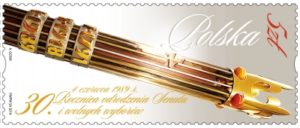
4 June 1989 … 30th Anniversary of the revival of the Senate
and free elections … denomination: 5,00 PLN;
number of stamps in set: 1; print run: 120.000 pcs.;
printing techniques: offset; paper: fluorescent; 6 stamps in sheet;
stamp size: 31,25 x 76,5 mm; number of FDC: 1; author: Andrzej Gosik;
circulation date: 04th June 2019.
Poczta Polska upamiętnia poprzez wydawnictwa filatelistyczne ważne wydarzenia z kart polskiej historii. Wybory z 4 czerwca 1989 roku to pierwsze po II Wojnie Światowej całkowicie wolne wybory, lecz tylko do jednej izby – Senatu. Odrodzona Izba Wyższa składała się z 99 senatorów rekomendowanych przez Komitety Obywatelskie „Solidarność” i tylko jednego spoza nich. Do Sejmu wybrano posłów w tzw. wyborach kontraktowych – kandydaci zgłoszeni przez grupy obywateli mogli swobodnie ubiegać się o 35% mandatów, które zostały objęte przez ówczesną stronę opozycyjną.
– Działalność filatelistyczna Poczty Polskiej pełni od dawna funkcję edukacyjną. Nasze znaczki przypominają o ważnych wydarzeniach w historii Polski, a do takich niewątpliwie należy odrodzenie Izby Wyższej Polskiego Parlamentu. Czujemy się w obowiązku upamiętnić to wydarzenie okolicznościowym znaczkiem pocztowym – mówi Przemysław Sypniewski, Prezes Zarządu Poczty Polskiej.

Autor waloru filatelistycznego Andrzej Gosik nawiązał do tradycyjnego symbolu władzy marszałkowskiej umieszczając na znaczku głownię laski marszałkowskiej, którą Andrzej Stelmachowski otrzymał od przedstawicieli Cechu Rzemiosł Artystycznych w kwietniu 1991 roku. Na mahoniowym drzewcu znajdują się daty: 3 V 1791, 11 XI 1918 i 4 VI 1989. Ta ostatnia upamiętnia pierwsze po wojnie demokratyczne wybory do Senatu. Laskę marszałkowską wieńczy stylizowana pozłacana korona piastowska Kazimierza Wielkiego, ozdobiona 4 jasnymi bursztynami.

Odkryj Polskę – Zabytki Fromborka
www.nbp.pl www.frombork.pl
Narodowy Bank Polski jest centralnym bankiem państwa odpowiadającym za politykę pieniężną i stabilność cen. Jego funkcje określa Konstytucja Rzeczypospolitej Polskiej i ustawa o NBP. NBP ma wyłączne prawo emisji pieniądza. Jako bank centralny nie prowadzi rachunków bankowych obywateli, nie przyjmuje od nich lokat, nie udziela kredytów. Prowadzi natomiast obsługę budżetu państwa, a także podmiotów sektora finansów publicznych. Gromadzi rezerwy walutowe państwa i zarządza nimi. Pełni funkcję banku banków, tworząc warunki do działania systemu bankowego. Jest również jednym z najważniejszych ośrodków naukowo-analitycznych w dziedzinie ekonomii i rynków finansowych. 22 maja 2019 roku Narodowy Bank Polski wprowadził do obiegu monetę z serii „Odkryj Polskę – Zabytki Fromborka” o nominale 5 zł.
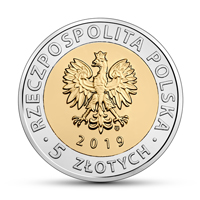

Nominał 5 zł … stop: pierścień MN25, rdzeń CuAl16Ni2;
stempel: zwykły; średnica: 24,00 mm; masa: 6,54 g; brzeg (bok):
moletowany nieregularnie; na boku ośmiokrotnie powtórzony napis: NBP,
co drugi odwrócony o 180 stopni, rozdzielony gwiazdkami;
nakład: do 1 200 000 szt.; Projektant monety: Dobrochna Surajewska;
Emitent: NBP; Na zlecenie NBP monety wyprodukowała Mennica Polska S.A.
Papież Innocenty IV w 1243 r. na terenach zajmowanych przez pogańskich Prusów erygował diecezję warmińską. Pierwsza katedra nowo utworzonej diecezji została ufundowana w 1260 r. w Braniewie, lecz po zniszczeniu miasta podczas powstania pruskiego bp Henryk Fleming zdecydował o wystawieniu nowej świątyni na ufortyfikowanym wzgórzu nad Zalewem Wiślanym we Fromborku. Prawdopodobnie w 1278 r. zbudowano w tym miejscu prowizoryczną drewnianą katedrę. W latach 1329−1388 wzniesiono nową, murowaną, która w stanie niemal nienaruszonym przetrwała do naszych czasów. Otoczono ją pierścieniem ceglanych murów obronnych, do których w kolejnych wiekach dobudowano kanonie, renesansowy pałac biskupi, barbakan, kapitularz oraz wieżę Radziejowskiego.
Katedra fromborska jest budowlą halową w stylu gotyckim, bez wieży, o długości 90 m, szerokości 22 m i wysokości ponad 16 m. Przykrywa ją jeden dach, na którym umieszczono centralnie sygnaturkę, a w narożnikach cztery ostrołukowe wieżyczki. W latach 1732−1735 do nawy południowej bp Krzysztof Szembek dobudował barokową kaplicę pw. Zbawiciela, przykrytą kopułą z latarnią. W architekturze katedry odnajdujemy elementy budowlane zarówno lokalne, pruskie, jak i flamandzkie oraz włoskie. Zachowało się bardzo bogate historyczne wyposażenie katedry. Ołtarz główny w prezbiterium z połowy XVIII w. zdobią obrazy Stefana Torellego ze sceną Wniebowzięcia NMP i męczeństwa św. Andrzeja. W prezbiterium znajdują się także gotyckie i rokokowe stalle kanonickie oraz niezwykle cenne malowane epitafium kanonika warmińskiego Bartłomieja Boreschowa z 1426 r. W północnej nawie kościoła ustawiono późnogotycki poliptyk wykonany w Toruniu w 1504 r. na zamówienie bpa Łukasza Watzenrode. Przy filarach znajduje się 16 marmurowych i drewnianych ołtarzy bocznych ufundowanych w XVII w.
W 1684 r. katedra zyskała doskonałej klasy organy wykonane w gdańskiej firmie Daniela Nitrowskiego, które współcześnie są wykorzystywane podczas corocznych letnich Międzynarodowych Festiwali Muzyki Organowej. Na posadzce i na ścianach katedry znajduje się 128 płyt nagrobnych i epitafiów biskupów warmińskich, kanoników i innych duchownych. Od średniowiecza do 1945 r. przy katedrze rezydowali kanonicy Warmińskiej Kapituły Katedralnej. Największą sławę zdobył kanonik Mikołaj Kopernik, który niemal nieprzerwanie przebywał i pracował na Wzgórzu Katedralnym od 1510 r. do swej śmierci w 1543 r. W tym miejscu astronom opracował największe dzieło De revolutionibus orbium coelestium (O obrotach sfer niebieskich), które zmieniło dotychczasowe pojmowanie wszechświata. Mikołaj Kopernik po śmierci spoczął w katedrze fromborskiej. Od 2004 r. prowadzono badania zmierzające do ustalenia miejsca jego pochówku. Z dużym prawdopodobieństwem odnaleziono wówczas fragmenty kości Kopernika, które 22 maja 2010 r. ponownie pogrzebano w bazylice archikatedralnej. Na grobie astronoma w południowej nawie świątyni ustawiono okazałe epitafium. Papież Paweł VI w 1965 r. ustanowił katedrę fromborską bazyliką mniejszą, a w 1992 r. została wyniesiona do rangi archikatedry warmińskiej. 16 września 1994 r. obiekt wpisano na listę pomników historii. Na rewersie monety znajduje się wizerunek bazyliki archikatedralnej Wniebowzięcia NMP i św. Andrzeja Apostoła we Fromborku. Ks. prof. dr hab. Wojciech Zawadzki.

Discover Poland – the Monuments of Frombork
www.nbp.pl www.frombork.pl
Frombork is a town in northern Poland, on the Vistula Lagoon, in Braniewo County, Warmian-Masurian Voivodeship. It had a population of 2,528 as of 2005. The town was first mentioned in the 13th century. In the early 16th century it was the residence of the astronomer Nicolaus Copernicus, who used it as a site for several of his observations.


The town and its 700-year-old cathedral were badly damaged in World War II. After the war the cathedral was meticulously reconstructed and is again a popular tourist destination. Frombork is known as “The Jewel of Warmia” because of its many historical sites. The Museum of Copernicus in Frombork holds exhibitions related to the astronomer, as well as to astronomy in general, and includes a planetarium. One of the biggest attractions is also the annual International Festival of Organ Music, held every summer. Between 1975 and 1998 the town was part of the Elbląg Voivodeship.

420. Rocznica urodzin Hetmana Stefana Czarnieckiego
www.nbp.pl
Narodowy Bank Polski jest centralnym bankiem państwa odpowiadającym za politykę pieniężną i stabilność cen. Jego funkcje określa Konstytucja Rzeczypospolitej Polskiej i ustawa o NBP. NBP ma wyłączne prawo emisji pieniądza. Jako bank centralny nie prowadzi rachunków bankowych obywateli, nie przyjmuje od nich lokat, nie udziela kredytów. Prowadzi natomiast obsługę budżetu państwa, a także podmiotów sektora finansów publicznych. Gromadzi rezerwy walutowe państwa i zarządza nimi. Pełni funkcję banku banków, tworząc warunki do działania systemu bankowego. Jest również jednym z najważniejszych ośrodków naukowo-analitycznych w dziedzinie ekonomii i rynków finansowych. 29 maja 2019 roku Narodowy Bank Polski wprowadził do obiegu złotą monetę o nominale 200 zł oraz srebrną monetę o nominale 10 zł „420. rocznica urodzin hetmana Stefana Czarnieckiego”.

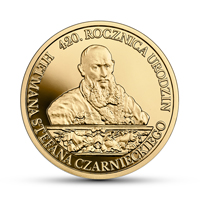
Nominał 200 zł … metal: Au 900/1000; stempel: lustrzany;
średnica: 27,00 mm; masa: 15,50 g; brzeg (bok): gładki;
nakład: do 1500 szt.
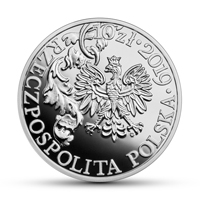
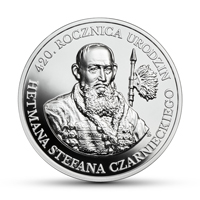
Nominał 10 zł … metal: Ag 925/1000; stempel: lustrzany (wysoki relief);
średnica: 32,00 mm; masa: 31,10 g; brzeg (bok): gładki;
nakład: do 15 000 szt.; Projektant monet: Dobrochna Surajewska;
Emitent: NBP; Na zlecenie NBP monety wyprodukowała
Mennica Polska S.A. Wizerunek hetmana Stefana Czarnieckiego
według portretu autorstwa Brodero Matthisena ze zbiorów
Zamku Królewskiego w Warszawie.
Stefan Czarniecki herbu Łodzia urodził się najprawdopodobniej w rodzinnym majątku Czarnca w powiecie chęcińskim w 1599 r. Dokładnej daty urodzin nie znamy. Nie ma w tym nic dziwnego − przyszły hetman polny koronny, pogromca Moskali i Szwedów wywodził się bowiem ze średniej szlachty, na tyle mało znaczącej, że narodziny kolejnych dzieci umykały uwadze współczesnych. Na wejście na karty historii trzeba było zapracować samemu. Stefan Czarniecki wcześnie wybrał karierę żołnierską i już od 1626 r. walczył ze Szwedami, Rosjanami i Kozakami. Jego talent wojskowy został dostrzeżony − w 1651 r. dowodził już pułkiem hetmańskim, a rok później awansował na oboźnego koronnego. W następnych latach powierzano mu dowództwo samodzielnych dywizji wojska, wysyłanych na Ukrainę przeciw Kozakom. Prawdziwą sławę zdobył jednak w czasie potopu szwedzkiego. Jako jedyny z wyższych rangą dowódców koronnych dochował wierności Janowi Kazimierzowi, dla którego dzielnie bronił Krakowa jesienią 1655 r.
Po powrocie króla do kraju został mianowany dowódcą armii wrandze regimentarza. Skutecznie prowadził wojnę szarpaną ze Szwedami, a w 1657 r. rozgromił armię Jerzego Rakoczego, księcia Siedmiogrodu sprzymierzonego ze Szwedami. Rok później wysłano go jako dowódcę wojsk posiłkowych koalicji antyszwedzkiej do Danii, gdzie odniósł nowe zwycięstwa. Powróciwszy do Polski, pokierował kampanią na Litwie przeciw Rosjanom, zadał im klęskę pod Połonką i zepchnął na wschodnie rubieże państwa (1660). Rok później rozgromił ich znów pod Kuszlikami. W dobie konfederacji wojskowych (1661−1663) pozostał wierny królowi, popierając planowane przez niego reformy elekcji i zwalczając promoskiewskich Kozaków.
W nagrodę za zasługi otrzymału schyłku życia awans na hetmana polnego koronnego (1665). Był też senatorem jako kasztelan kijowski (1655), a następnie wojewoda ruski (1657) i kijowski (1664). Dla późniejszych pokoleń stał się symbolem żołnierza i patrioty, którego imię uwieczniono w Mazurku Dąbrowskiego. Na rewersie złotej monety został umieszczony wizerunek hetmana Stefana Czarnieckiego, poniżej fragment panoplium − motywu dekoracyjnego, będącego kompozycją elementów uzbrojenia, sztandarów i proporców. Na awersie pokazano fragment panoplium oraz buławę hetmana Stefana Czarnieckiego. Na rewersie srebrnej monety znajduje się wizerunek hetmana Stefana Czarnieckiego, w tle znak hetmański. Na awersie umieszczono fragment labrów (roślinnych ornamentów) tarczy herbowej Łodzia – herbu rodu hetmana Stefana Czarnieckiego. Informacja: Dariusz Milewski.

420th Anniversary of the Birth of Hetman Stefan Czarniecki
www.nbp.pl
Narodowy Bank Polski is the central bank of the State, responsible for its monetary policy and price stability. The Bank’s functions are described in the Constitution of the Republic of Poland and the Act on NBP. NBP holds the exclusive right to issue the currency of the Republic of Poland. As the central bank, it does not provide accounts for the general public, accept deposits from or extend loans to individuals. It acts as a banker to the State budget and public sector entities. NBP also holds and manages the foreign exchange reserves of the State. Finally, it functions as a banker to banks, creating conditions for the operation of the Polish banking system. Narodowy Bank Polski is one of the most important research and analytical centres in the fields of economics and financial markets. On 29 May 2019 Narodowy Bank Polski issued into circulation a gold collector coin with a face value of 200 zł and a silver collector coin with a face value of 10 zł – “420th Anniversary of the Birth of Hetman Stefan Czarniecki”.


Face value 200 zł … Metal: Au 900/1000; Finish: proof;
Diameter: 27.00 mm; Weight: 15.50 g; Edge: plain;
Mintage: up to 1,500 pcs.


Face value 10 zł … Metal: Ag 925/1000; Finish: proof (high relief);
Dimensions: 32.00 mm; Weight: 31.10 g; Edge: plain;
Mintage: up to 15,000 pcs; Designer: Dobrochna Surajewska;
Issuer: NBP; The coins, commissioned by NBP, were struck by
Mennica Polska S.A. The image of Stefan Czarniecki was produced
according to a portrait by Brodero Matthisen from the collection
of the Royal Castle in Warsaw.
Stefan Czarniecki, of the Łodzia coat of arms, was most likely born in the family estate of Czarnca in the Chęciny County in 1599. The exact date of his birth is not known. This is not surprising as the future field hetman of the Polish Crown, victor of the Muscovites and the Swedes, came from the so-called middle nobility. His family was not significant enough for the birth of the subsequent children to capture the attention of its contemporaries. As a result, Czarniecki had to earn his place in the history books on his own. Stefan Czarniecki chose a career in the army early on and starting from 1626 he fought against the Swedes, the Russians, and the Cossacks. His military talent was recognized − in 1651 he was already commanding a hetman’s regiment, and a year later he was promoted to the position of the crown camp leader. In the subsequent years, he was entrusted with the command of independent army divisions that were sent to Ukraine to fight against the Cossacks. However, he gained real fame during the Swedish Deluge. As the only higher-ranked Crown commander, he remained loyal to King John Casimir Vasa, for whom he bravely defended Kraków in the autumn of 1655. After the king returned to the country, Czarniecki was appointed an army commander in the rank of army leader. He successfully waged war against the Swedes, employing “hit and run” tactics, and in 1657 he defeated the army of George II Rákóczi, the prince of Transylvania who was allied with the Swedes. He achieved further victories one year later when he was sent to Denmark as the commander of reinforcements for the anti-Swedish coalition.
After returning to Poland, he led the campaign against the Russians in Lithuania, defeating them in the battle of Połonka, and forcing them to retreat to the country’s eastern frontiers (1660). One year later, he crushed the Russians again in the battle of Kuszliki. During the period of military confederations (1661-1663), he remained loyal to the king, supporting the planned election reforms and fighting against the pro-Muscovite Cossacks. In recognition of his merit, near the end of his life, he was promoted to the office of the field crown hetman (1665). He was also a senator as the castellan of Kiev (1655), and then the voivode of Ruthenia (1657) and of Kiev (1664). For the subsequent generations, he became a symbol of a soldier and a patriot whose name was immortalized in Dąbrowski’s Mazurka. The reverse of the gold coin features the image of hetman Stefan Czarniecki, below there is a fragment of a panoply − a decorative motif combining the elements of armour, banners, and pennants. The obverse depicts a fragment of the panoply and the baton of hetman Stefan Czarniecki. The reverse of the silver coin carries the image of hetman Stefan Czarniecki, with the hetman’s sign in the background. On the obverse, there is a fragment of the mantling (a vegetal ornament) of the heraldic shield of the Hetman Stefan Czarniecki’s family line – Łodzia. Info: Dariusz Milewski.

Wielkie aktorki – Helena Modrzejewska
www.nbp.pl
Narodowy Bank Polski jest centralnym bankiem państwa odpowiadającym za politykę pieniężną i stabilność cen. Jego funkcje określa Konstytucja Rzeczypospolitej Polskiej i ustawa o NBP. NBP ma wyłączne prawo emisji pieniądza. Jako bank centralny nie prowadzi rachunków bankowych obywateli, nie przyjmuje od nich lokat, nie udziela kredytów. Prowadzi natomiast obsługę budżetu państwa, a także podmiotów sektora finansów publicznych. Gromadzi rezerwy walutowe państwa i zarządza nimi. Pełni funkcję banku banków, tworząc warunki do działania systemu bankowego. Jest również jednym z najważniejszych ośrodków naukowo-analitycznych w dziedzinie ekonomii i rynków finansowych. 11 czerwca 2019 roku Narodowy Bank Polski wprowadził do obiegu srebrną monetę o nominale 20 zł z serii „Wielkie aktorki” – Helena Modrzejewska.
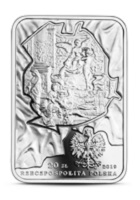

Nominał 20 zł … metal: Ag 925/1000; stempel: lustrzany, wklejka porcelanowa;
wymiary: 40,00 x 28,00 mm; masa: 28,28 g; brzeg (bok): gładki;
nakład: do 16 000 szt.; Projektant monet: Anna Wątróbska-Wdowiarska;
Emitent: NBP; Na zlecenie NBP monety wyprodukowała
Mennica Polska S.A.
Helena Modrzejewska (1840–1909) była wybitną aktorką, wielką legendą polskiego teatru, gwiazdą dwóch kontynentów. Słynęła z urody, talentu i szlachetności. Była nie tylko wyjątkową artystką, ale też gorliwą patriotką i filantropką. Urodziła się w Krakowie; plotka głosiła, że jej ojcem był książę Eustachy Sanguszko. Debiutowała dzięki protekcji aktora Gustawa Zimajera, który umożliwił jej debiut w 1861 roku w Bochni. Wkrótce został ojcem jej dzieci (córka zmarła tragicznie w dzieciństwie, syn Rudolf – znany jako Ralf Modjeski – stał się cenionym amerykańskim budowniczym mostów).
Po czterech latach występów w teatrach prowincjonalnych Modrzejewska uciekła od Zimajera i od 1865 roku odnosiła sukcesy w teatrze krakowskim. W latach 1868−1876 występowała w Warszawie, gdzie szybko zyskała status gwiazdy. Razem z mężem, hrabią Karolem Chłapowskim, przeniosła się do Ameryki. Jako Helena Modjeska występowała w wielu teatrach amerykańskich, odbywając triumfalne podróże artystyczne. Nie zapomniała jednak o ojczyźnie i niemal co roku przyjeżdżała na występy gościnne – najczęściej do Lwowa i rodzinnego Krakowa, gdzie zaangażowała się w zbiórkę pieniędzy na budowę nowego teatru (obecnie Teatr im. Juliusza Słowackiego). Później wielokrotnie występowała na tej scenie, zachwycając publiczność swoimi słynnymi rolami, m.in.: szekspirowskiej Lady Makbet, Marii w Warszawiance Wyspiańskiego, Marii Stuart Słowackiego wg Schillera, Damy kameliowej Dumasa. Ostatnie występy Modrzejewskiej w ojczyźnie odbyły się w Krakowie w 1903 roku. Zmarła w swojej posiadłości w Kalifornii, spoczywa na cmentarzu Rakowickim w Krakowie.
Na rewersie monety umieszczono wizerunek Heleny Modrzejewskiej z portretu Franka Fowlera z 1884 r., z lewej strony autograf, a w prawym dolnym rogu kolorowy wachlarz sceniczny aktorki. Na awersie pokazano fragment kurtyny Henryka Siemiradzkiego z Teatru im. Juliusza Słowackiego w Krakowie, przedstawiający grupę Natchnienia, Piękna i Prawdy oraz Tragedię (w czarnej szacie), Komedię (z maską antyczną w dłoni) i Błazna bawiącego się marionetkami. Informacja: Diana Poskuta-Włodek.

Great Actresses – Helena Modrzejewska
www.nbp.pl
Narodowy Bank Polski is the central bank of the State, responsible for its monetary policy and price stability. The Bank’s functions are described in the Constitution of the Republic of Poland and the Act on NBP. NBP holds the exclusive right to issue the currency of the Republic of Poland. As the central bank, it does not provide accounts for the general public, accept deposits from or extend loans to individuals. It acts as a banker to the State budget and public sector entities. NBP also holds and manages the foreign exchange reserves of the State. Finally, it functions as a banker to banks, creating conditions for the operation of the Polish banking system. Narodowy Bank Polski is one of the most important research and analytical centres in the fields of economics and financial markets. On 11 June 2019, Narodowy Bank Polski issued into circulation a silver coin with a face value of 20 zł of the series “Great Actresses” – Helena Modrzejewska.


Face value 20 zł … Metal: Ag 925/1000; Finish: proof, porcelain insert;
Dimensions: 40.00 x 28.00 mm; Weight: 28.28 g; Edge: plain;
Mintage: up to 16,000 pcs; Designer: Anna Wątróbska-Wdowiarska;
Issuer: NBP; The coins, commissioned by NBP, were struck by
Mennica Polska S.A.
Helena Modrzejewska (1840–1909) was a remarkable actress, a great legend of the Polish theatre and a star of two continents. She was famous for her beauty, talent, and generosity. Not only was she an extraordinary artist, but also an ardent patriot and philanthropist. Modrzejewska was born in Kraków; gossip had it that her father was Duke Eustachy Sanguszko. She made her debut thanks to the recommendation of actor Gustaw Zimajer, who enabled her to make a debut appearance in 1861 in Bochnia. He was soon to become the father of her children (their daughter died tragically in childhood, and their son Rudolf – also known as Ralf Modjeski – became an acclaimed American bridge constructor). After four years of acting in provincial theatres, Modrzejewska ran away from Zimajer, and from 1865 was a successful actress in the Kraków theatre.
In 1868-1876 she performed in Warsaw, where she quickly rose to stardom. Together with her husband, Count Karol Chłapowski, she moved to America. As Helena Modjeska, she acted in many American theatres, giving triumphant artistic tours. However, she did not forget her home country and travelled every year to give guest performances – usually to Lvov and her native Kraków, where she became engaged in raising money for the construction of a new theatre (currently the Juliusz Słowacki Theatre). Later on, she performed on this stage on many occasions, enthralling the audience with her famous roles, e.g. the Shakespearean Lady Macbeth, Maria in Warszawianka by Wyspiański, Maria Stuart by Słowacki according to Schiller and The Lady of the Camellias by Dumas. Modrzejewska gave her last performances in Poland in Kraków in 1903.
She died at her mansion in California and was buried at the Rakowicki Cemetery in Kraków. The reverse of the coin features an image of Helena Modrzejewska from a portrait by Frank Fowler from 1884; on the left – the actress’s autograph, in the bottom right corner – her colourful stage fan. The obverse shows a fragment of the stage curtain designed by Henryk Siemiradzki from the Juliusz Słowacki Theatre in Kraków, depicting a group of Inspiration, Beauty and Truth, Tragedy (in a black robe), Comedy (with an antique mask in her hand), and Jester playing with puppets. Info: Diana Poskuta-Włodek.


The Universal Postal Union
www.canadapost.ca https://postagestampguide.com
Have you ever written a letter to a person in another country? Did you ever wonder why a letter carrier in Paris, Tokyo or Madrid would deliver it for you with only your Canada stamp on it? Had you mailed that letter a hundred years ago, delivery would have been a problem. But now, thanks to the U.P.U., it’s not a concern.
Before the U.P.U., a letter was subject to the rates of each country it passed through on the way to its destination. Most postal treaties were between individual nations, often based on different methods of charging. By the mid-1800s, postal clerks were struggling with over 1200 different rate schedules and currencies. On September 15, 1874, the postal administrators of 22 countries met in Berne, Switzerland, on the initiative of Heinrich von Stephan, German Minister of Posts, to simplify international postal regulations. On October 9, 1874, a treaty established the General Postal Union, providing uniform international rates and transit fees.
In 1878, the organization was renamed the Universal Postal Union. That same year Canada enrolled as a member. Now 150 plus member nations strong, the U.P.U. still maintains its headquarters at Berne, Switzerland. A multilingual journal is published, and an information centre is provided. The main legislative body, the Universal Postal Congress, meets every five years. In 1957, the 14th Congress met in Ottawa. The 17th Congress held this year in Lausanne, Switzerland, marked 100 years of the Union’s success. (45-IX-19)
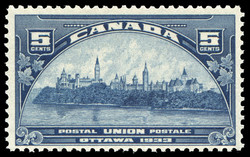
Denomination: 5¢ … Perforation or Dimension: 11;
Quantity: 5,100,000; Date of Issue: May 18, 1933;
Printer: British American Bank Note Company.
Postal Union, Ottawa, 1933 … About Stamp … The “Commission préparatoire” or World’s Executive Committee of the International Postal Union held its sessions in Ottawa from 18th May to 28th June 1933. This committee was constituted after World War I to deal with innumerable problems of international postal service arising after that upheaval. The Commission performed a valuable service in simplifying objectives by reducing the agenda of the various World Postal Congresses to the minimum.
Parliament Hill … View of Parliament Hill, Ottawa, from a photograph. The scene shows, from left to right, the following buildings in the Parliamentary and Department group: Library of Parliament, Centre Block, Peace Tower, West Block, and Confederation Building, and the wooded cliffs of Parliament Hill above the Ottawa River.

Denomination: 5¢ … Perforation or Dimension: 12;
Quantity: 74,700,000; Date of Issue: August 14, 1957;
Printer: Canadian Bank Note Company, Limited.
Universal Postal Union (UPU) Congress, Ottawa, 1957 … About Stamp … The Universal Postal Union with headquarters at Berne, Switzerland and organized in 1874, bound many countries of the world into a single postal territory for the reciprocal exchange of mail. Delegates from the member nations meet about every five years to decide upon policy and administrative matters. Canada’s membership in the Union dates from 1878. For eighty-three years at the time of this issue, despite wars and upheavals of all kinds, the Universal Postal Union has carried on its work. The U.P.U. exemplifies international co-operation at its highest level when the efforts of all ruling authorities are dedicated to constructive, peaceful work of delivering mail. Designed by Carl Mangold. Picture engraved by Yves Baril. The designer’s initials can be found in the bottom-right corner of the stamp. The initial M belongs to Carl Mangold. The Peace Tower … The Peace Tower on Parliament Hill, Ottawa, with a small post horn in the left upper corner.
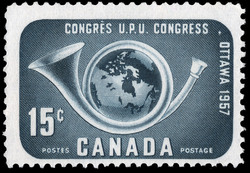
Denomination: 15¢ … Perforation or Dimension: 12;
Quantity: 7,000,000; Date of Issue: August 14, 1957;
Printer: Canadian Bank Note Company, Limited.
Universal Postal Union …
A map of Canada encircled by a post horn.


Historic Covered Bridges: PermanentTM Domestic stamps
www.canadapost.ca
Take a trip through days gone by with this booklet of 10 PermanentTM domestic stamps of Canada’s historic covered bridges. Each of the five stamps features a colour photograph of the bridge, its name, and key details, including the year it was built, the length of the span and the type of trusses used. New Brunswick’s Hartland Covered Bridge, with a span of 391 metres across the Saint John River, is the longest covered bridge in the world. Quebec’s Powerscourt Bridge is also known as the Percy Bridge. Built-in 1861, it is considered Canada’s oldest covered bridge and is the world’s only remaining example of the McCallum arched truss design. Also in Quebec, the Félix-Gabriel-Marchand Bridge is the province’s longest covered bridge, at 152 metres. Ontario’s last remaining historic covered bridge is the West Montrose Bridge. Also known as “the kissing bridge,” it spans the Grand River north of Waterloo. British Columbia’s Ashnola No.1 Bridge is also the last of its kind in that province. During a 1926 rebuild, its Howe trusses were sheathed in wood panelling, while the overhead cross-bracing was left exposed.

Stamp value: PermanentTM (domestic rate); Issue date: June 17, 2019;
Stamp designer: Paprika; Quantity products: 200,000;
Dimensions: 38 mm x 38 mm.
Historic Covered Bridges: Souvenir Sheet … Experience some transportation treasures of rural Canada with this colourful Souvenir Sheet featuring Canada’s historic covered bridges. This collectible features five PermanentTM domestic stamps, each depicting a different covered bridge from across the country. The stamps feature a photograph of the featured bridge, its name, and key details, including the year it was built, the length of the span and the type of trusses. Stamp value: PermanentTM (domestic rate); Quantity products: 80,000; Dimensions:134 mm x 86 mm.

Historic Covered Bridges: Souvenir Sheet Official First Day Cover … Get a glimpse of yesteryear with this Souvenir Sheet Official First Day Cover of Canada’s historic covered bridges. This colourful collectible features five PermanentTM domestic stamps, each depicting a different heritage bridge from across the country. Each of the five stamps features a colour photograph of the bridge, its name, and key details, including the year it was built, the length of the span and the type of trusses used. The souvenir sheet and attached Official First Day Cover feature an interlocking truss design. Quantity produced: 7,000; Dimensions: 190 mm x 112 mm; Cancellation site: Hartland NB.
Historic Covered Bridges: Postage-paid postcard – Covered Bridges (Set of 5) … Send a snapshot of the past with this set of five postage-paid postcards featuring Canada’s historic covered bridges. The colourful postcards in this set are enlargements of the photographs on the domestic stamps from this issue. The postcards can be mailed from Canada to anywhere in the world.
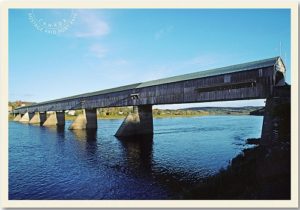
Postage-paid postcard – Hartland Covered Bridge (NB) … Send a snapshot of days gone by with this postage-paid postcard featuring New Brunswick’s historic Hartland Covered Bridge. One of five postcards from the Historic Covered Bridges collection, this postcard features an enlargement of the photograph on the domestic stamp. The postcard can be mailed from Canada to anywhere in the world. The stamp features a photograph of the bridge, its name, the year it opened, and other key details, including the length of the span and the type of trusses used. A conventional bridge when it opened in 1901, the Hartland Bridge was covered in 1922. At 391 metres over the Saint John River, it is the longest covered bridge in the world. The bridge was designated a National Historic Site in 1977 and a provincial Historic Place in 1984.
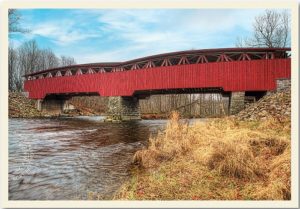
Postage-paid postcard – Powerscourt (Percy) Bridge (QC) … Send a snapshot of history – anywhere in the world – with this colourful postage-paid postcard featuring Quebec’s Powerscourt Bridge. This postcard, one in a set of five, is an enlargement of the photograph on the domestic stamp from the Historic Covered Bridges issue. Also known as Percy Bridge, this 50-metre span across the Châteauguay River was completed in 1861. It is now considered to be Canada’s oldest covered bridge. It was built using McCallum inflexible arched trusses, which were developed for use in railway bridges due to their superior strength and rigidity. Powerscourt is the world’s only remaining bridge with these trusses. The bridge was designated a National Historic Site of Canada in 1984 and a Quebec historic monument in 1987.

Postage-paid postcard – Félix-Gabriel-Marchand Bridge (QC) … Post a piece of history with this postage-paid postcard featuring Quebec’s historic Félix-Gabriel-Marchand Bridge. This colourful, elegant postcard, one in a set of five, is an enlargement of the photograph on the domestic stamp from the Historic Covered Bridges issue. Quebec’s longest covered bridge, at 152 metres, this bridge is named for Félix-Gabriel Marchand, premier of Quebec from 1897 to 1900. Built in 1898, it features a combination of Queen Post and Town lattice trusses, making it unique among bridges in the province. The bridge was declared a historic monument of Quebec in 1988.
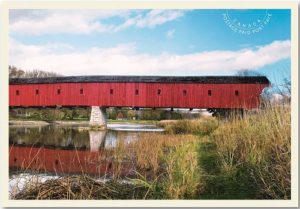
Postage-paid postcard – West Montrose Covered Bridge (ON) … Share a bit of nostalgia with this postage-paid postcard featuring Ontario’s historic West Montrose Covered Bridge. Ontario’s only remaining historic covered bridge, the West Montrose Covered Bridge crosses the Grand River in Woolwich Township, north of Waterloo. Also known as “the kissing bridge,” the 60-metre span opened in 1881. It was added to the Canadian Register of Historic Places in 2007.
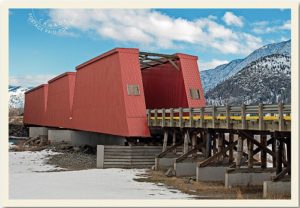
Postage-paid postcard – Ashnola No.1 Bridge (BC) … Send a snapshot of history – anywhere in the world – with this colourful postage-paid postcard featuring British Columbia’s Ashnola No.1 Bridge. British Columbia’s only remaining historic covered bridge, the Ashnola No.1 Bridge carried the Great Northern Railway over the Similkameen River near the town of Keremeos after it opened in 1907. The bridge was rebuilt in 1926 with its Howe trusses sheathed in wood panelling and the overhead cross-bracing left exposed. The railway tracks were removed in 1954, and the bridge was converted for vehicle traffic in 1961.


2019 … $30 Pure Silver Coin – 60 Years of Prominence:
The St. Lawrence Seaway
www.canadapost.ca www.mint.ca
60 Years of Prominence: The St. Lawrence Seaway … Its waters serve as the economic lifeblood for two nations. Its channels and locks connect North America’s heartland to the Atlantic Ocean—and the world beyond. In 1959, the newly completed St. Lawrence Seaway was hailed as one of the greatest engineering feats of the 20th century. Its canals and lock systems transformed a centuries-old trade route into a crucial commercial artery for the modern age. Over the last 20 years, the St. Lawrence Seaway Management Corporation improved lock operations by developing and implementing a Hands-Free Mooring system and converting the locks to remote control operation. These are the most significant changes since the Seaway’s construction—innovations that have increased efficiency and safety while making the waterway more competitive than ever. Today, the Seaway is an important shipping route for two nations, as well as a beloved destination for recreational boaters. About 40 million metric tons of vital cargoes transit the Seaway’s locks each year.
Join us in commemorating the 60th anniversary of the St. Lawrence Seaway with a pure silver coin that is anything but conventional. While the view inside a lock highlights the waterway’s legacy, the anchor-chain rim symbolizes longevity and gives your coin its never-before-seen shape—a fitting tribute to an innovative and ever-evolving marvel.
“The St. Lawrence Seaway is a vital waterway, serving as a key part of the North American logistics chain and as an important gateway for trade with over 50 nations across the globe. Moving cargo over water supports an immense number of jobs, eases congestion on our road and rail links, and provides the most energy-efficient means of getting tonnage to its destination. Stakeholders win on all counts!” Terence Bowles, President, and CEO of The St. Lawrence Seaway Management Corporation.
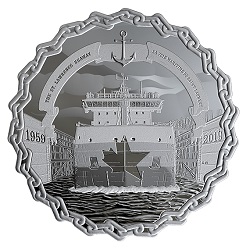
Face value: 30 dollars … Composition: 99.99% Pure Silver;
Mintage: 2,000; Finish: proof; Edge: plain;
Weight: 62.69g; Diameter: 52.6 mm; Artist: Claire Watson (reverse).
Design: Designed by Claire Watson, your coin is a stylized, symbolic celebration of the St. Lawrence Seaway on its 60th anniversary. It features a head-on view of an eastbound bulk carrier (laker) transiting through the St. Lambert Lock, where the Montréal skyline is visible in the distance. A split maple leaf and star represents a binational partnership between Canada and the United States. A symbol of strength and longevity, an anchor chain forms the rim like corrugated denticles and gives the coin its unusual shape. The reverse includes the words “THE ST. LAWRENCE SEAWAY” and “LA VOIE MARITIME DU SAINT-LAURENT” on a scrolling banner that also bears a stylized anchor. The obverse features the effigy of Her Majesty Queen Elizabeth II by Susanna Blunt.
“My initial design was much simpler. I wasn’t aware of the process or how detailed the art could be when translating to engraving. My biggest challenge was creating a technical design centred on man-made structures, versus the more organic, nature-inspired subject matter I’m used to working with. It was great for me to step out of my comfort zone and try something new.” Claire Watson, Artist. “The shaped, engraved rim sets this coin apart by providing an additional canvas for engraving that matches the nautical theme of the coin.” Howard Lam, Engraver, Royal Canadian Mint.
Did you know… It is the heart of a 3,700 kilometre-long corridor that connects the Great Lakes and the Atlantic Ocean. Stretching from Montréal to Lake Ontario, the St. Lawrence Seaway officially includes 13 Canadian and 2 American locks. Together, these lock systems can raise ships that are over two football fields in length more than 168 metres above sea level—about the height of a 60-story building.
The St. Lawrence Seaway has a big economic impact. It supports nearly 93,000 jobs (including 59,800 in Canada) and generates more than $16.8 billion in economic activity within North America. When combined with the Great Lakes and lower St. Lawrence River, the entire Great Lakes-St. Lawrence River Waterway (from Lake Superior to the Atlantic Ocean) supports over 328,500 jobs in North America and generates $59.2 billion.
Almost 3 billion tonnes of cargo valued at over $400 billion has sailed through the Seaway’s locks since 1959. In a typical year, about 25% of all Seaway traffic is international. Grain and iron ore each represents about 25% of Seaway tonnage, with other dry bulk cargoes (i.e. potash and road salt) contributing another 25%. The balance consists of breakbulk shipments (i.e. steel ingots), project cargo (i.e. wind turbine blades) and liquid bulk (i.e. refined fuel products).
A single ship can transport up to 30,000 tonnes of cargo—the equivalent of 964 truckloads and 301 rail cars. Maritime transport has the smallest carbon footprint compared to trucking and rail transport, and ships have better fuel efficiency overall: one tonne of cargo can travel 243 km on a single litre of fuel. New regulations in 2006 have also reduced the risk of aquatic invasive species, while a joint inspection program ensures compliance with updated safety and environmental standards.
Sail the St. Lawrence Seaway with this specially shaped commemorative coin… It connects North America’s heartland to the Atlantic Ocean, and the world beyond. In 1959, the newly completed St. Lawrence Seaway was hailed as one of the greatest engineering feats of the 20th century. Today, it continues to be an important commercial artery in a modern age, as well as a destination for recreational boaters. This 60th Anniversary commemorative piece highlights the Seaway’s legacy with a view inside one of its 15 locks. A symbol of strength and longevity, the anchor chain is a marine-inspired twist that allows the design to bleed into the coin’s unusual shape—a fitting tribute to a modern marvel.
Be the first to own a corrugated-edged 2 oz. coin. The anchor-chain rim is a marine-inspired twist on traditional denticles. This corrugated-edged 2 oz. coin (a first) is made possible by the creative application of newer technology that has never been used on a coin this size (50 mm)—until now.
Diplomacy, innovation, a lifeline: A love letter to an engineering marvel: This pure silver coin commemorates the 60th anniversary of the St. Lawrence Seaway with a bold design that pays tribute to a vital waterway. Includes the symbols of two countries that share one resource: A split maple leaf and star represents the Seaway as a binational partnership between Canada and the United States.


2019 … $20 Pure Silver Coin –
100th Anniversary of the First Non-Stop Transatlantic Flight
www.canadapost.ca www.mint.ca
On June 14, 1919, a modified First World War Vickers Vimy bomber lifted off from St. John’s, Newfoundland and flew straight into the history books. British aviators John Alcock and Arthur Whitten Brown persevered through a rough takeoff, equipment failures, fog, ice and snow before crash-landing the next day in County Galway, Ireland. In doing so, they became the first aviators to cross the Atlantic Ocean in less than 72 consecutive hours — a new milestone in aviation history.
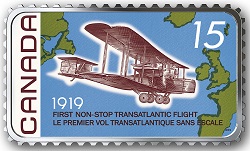
Face value: 20 dollars … Composition: 99.99% Pure Silver;
Mintage: 5,000; Weight: 31.86 g; Diameter: 30 mm x 51 mm;
Finish: Proof with colour.
In 1969, Canada Post issued a 15-cent stamp to commemorate the 50th anniversary of the first non-stop transatlantic flight. Now, 50 years after that special issue — and on the centennial of this aviation first — the Canadian stamp is forever immortalized on this stamp-shaped, 99.99% pure silver coin. A stamp-shaped coin that pays tribute to Canadian philately. A classic stamp design is now available 50 years after its original issue, and on the centennial of this historic flight. A serrated edge gives the coin its unique shape by mimicking the look of stamp perforations. The engraved reproduction is just as detailed and colourful as the original stamp issued in 1969.

2019 … 5-Ounce Pure Silver Coin – Big Coin Series: 50-Cent Coin
www.canadapost.ca www.mint.ca
Since 1937, the 50-cent piece carries the history of Canada on its reverse, where the Canadian Coat of Arms references Canada’s colonial roots and its status as a sovereign state. Though it was among the very first Canadian coins struck at the Ottawa branch of the Royal Mint in 1908, the 50-cent piece is a rare sight in everyday commercial transactions today. Since 2004, it has only been sold directly from the Royal Canadian Mint as a collector product. This 5 oz. a pure silver version of the 50-cent piece features Canada’s Coat of Arms. With only two exceptions, the image has been used continuously on Canada’s 50-cent coin since 1959. Silver and gold, together on one coin! New for 2019: Reverse gold plating adds a warm-toned gleam that creates a beautiful contrast next to the silver shine of the engraved relief. Part of the Royal Canadian Mint’s annual Big Coin Series, a highly sought-after series of 5 oz. 99.99% pure silver versions of current and historical Canadian circulation coinage. Mintage has been lowered from 1,500 to 1,250 in 2019—the lowest ever for the popular Big Coin Series, which has a history of selling quickly.
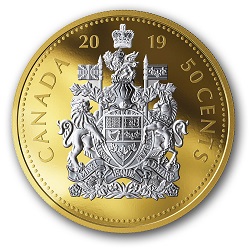
Face value: 50-Cent … Composition: 99.99% Pure Silver;
Mintage: 1,250; Weight: 157.6 g; Diameter: 65.25 mm;
Finish: Proof; Artist: Cathy Bursey-Sabourin.


2019 … D-Day Commemorative Collector Keepsake
www.canadapost.ca www.mint.ca
D-Day Dedication (1944-2019) … Remembering Canada’s role in the largest seaborne invasion in history. What thoughts go through a soldier’s mind in the moments before battle? This riveting coin takes you aboard a landing craft where Canadian soldiers are peering over the ramp as they approach the coast of Normandy (France) on D-Day. Their mission: to establish a beachhead at Juno Beach.
For months prior, Allied aircraft bombed German installations along the heavily defended coast in preparation for the arrival of a massive invasion force—150,000 Allied troops that came ashore on June 6, 1944. Among them, 14,000 Canadians who secured their beachhead (Juno) before moving to capture German positions further inland. On D-Day alone, 359 Canadians lost their lives, and by the time Paris was liberated on August 25th, more than 5,000 Canadians had made the ultimate sacrifice to regain critical ground for the Allies in Western Europe.
This six-coin set includes 5-cent, 10-cent, 25-cent and $1 circulation coins, plus two versions (engraved-only and selectively coloured) of the D-Day-themed $2 coin. The $2 D-Day circulation coin honours the soldiers who fought the Normandy Campaign and turned the tide towards victory the following year. A must-have 75th D-DAY commemoration, and a lasting tribute to anyone who has served in the Canadian military.
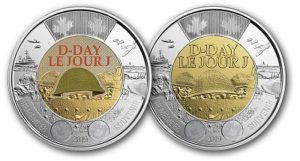
Face value 2 dollars … Composition: Base metal outer ring:
three-ply nickel finish plated steel; inner core: three-ply brass
finish plated aluminum bronze; Mintage:100,000;
Finish: Circulation; Weight: 6.99 g; Diameter: 28 mm;
Edge; interrupted serrations;
Artist: Alan Daniel (reverse), Susanna Blunt (obverse).
Special-themed coloured $2 coin design: Your riveting coin design by Canadian artist Alan Daniel is charged with tense anticipation as Canadian soldiers peer from their landing craft en route to Juno Beach. This compelling landing craft perspective extends beyond the inner core to the outer ring where naval and air forces support the Allied landings. D-DAY/LE JOUR J is engraved above the soldiers’ helmets. At the bottom, the words REMEMBER/SOUVENIR flank 2019.
Did you know… * “D-Day” is military shorthand to ensure the dates for field missions remain secret. The letter “H” was also used for “hour”, e.g. D-2 would mean two days before D-Day, while H+3 would indicate 3 hours after H-Hour. It is unclear how the invasion of June 6, 1944 became known as “D-Day.” Its official name was “Operation Neptune.” * Innovative tanks were developed to ensure victory on D-Day and throughout the Normandy Campaign. The Sherman DD could swim; the Sherman Crab had chain mail that would spin to detonate mines and shred barbed wire; the Churchill Bobbin lay matting on sand; and the Churchill Fascine filled enemy trenches with brushwood. * Supplying the troops after D-Day and throughout the Normandy Campaign was a massive undertaking. Portable docking facilities were built to ensure ships could deliver food, medical supplies, weapons and troops to the European continent. A long underwater pipeline called “Pluto” (Pipe Lines Under The Ocean) was also built to carry fuel from England to Normandy.
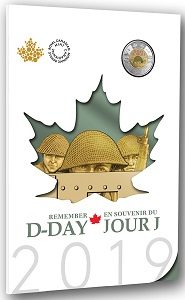
D-Day in Numbers: *80 kilometres of heavily defended Normandy coast was the target invasion zone on D-Day 5 German-occupied beaches code-named Sword, Gold (assigned to the British forces), Juno (Canadians), Omaha and Utah (Americans) were captured. * 450+ Canadians parachuted inland before dawn on June 6th to flank the landings. * 14,000 Canadian troops came ashore as part of the 150,000 Allied assault force 10,000 sailors and 110 ships from the Royal Canadian Navy (including destroyers, corvettes, minesweepers, landing ships, and landing craft) were among the 7,000 Allied vessels that supported the landings. * 55 Royal Canadian Air Force squadrons earned the Battle Honour Normandy 1944 as part of an Allied Air offensive that included 4,000 bombers plus some 3,700 fighters and fighter-bombers that attacked prior to D-Day, during the landings, and throughout the campaign. * 359 Canadians lost their lives on D-Day, with the total number of Canadian fatalities rising to more than 5,000 by the end of the campaign.


2019 … $3 Pure Silver Coin –
75th Anniversary of the Normandy Campaign: D-Day at Juno Beach
www.canadapost.ca www.mint.ca
A tribute to those who came ashore on D-Day … On June 6, 1944, 14,000 Canadians stepped forward and fought to secure a beachhead on an 8-km stretch of Normandy coast. Many fell before reaching the shore; still, the brave Canadians pushed on, advancing farther than any of the Allies and clearing the way for the invading forces that followed. This powerful coin design honours the Canadian soldiers who landed on Juno Beach and helped secure an Allied foothold in Western Europe. Although their boot prints in the sand have long washed away, their imprint on history will endure forever. Beautifully crafted, this D-Day commemorative piece captures the moment Canadian soldiers set foot on Juno Beach on the morning of June 6, 1944. Canadians played an important role on D-Day and throughout the Battle of Normandy. This is our way of honouring their legacy. A treasured highlight of any military or history-themed collection, this superbly crafted piece will inspire pride in any veteran who receives it as a heartfelt gift or personal tribute.

Face value 3 dollars … Composition: 99.99% Pure Silver;
Mintage:100,000; Finish: Reverse Proof; Weight: 7.96 g;
Diameter: 27 mm; Artist: Glen Loates.
Stepping off the LCA, I plunged into action. It was a 45-metre dash through the cold surf just to reach the shore. Now, it’s a mad race across the open beach to reach the seawall. We’ve come under heavy fire every step of the way. But we’re doing the unthinkable here: we’re breaching the Atlantic Wall, like a giant wave crashing down on the occupying forces in Western Europe. Every new boot print in the sand is one step closer to victory…
The first step into battle takes incredible courage… On June 6, 1944, 14,000 Canadians stepped forward and fought to secure a beachhead on an 8-km stretch of Normandy coast. Many fell before reaching the shore; still, the brave Canadians pushed on, advancing farther than any of the Allies and clearing the way for the invading forces that followed. This powerful coin design honours the Canadian soldiers who landed on Juno Beach and helped secure an Allied foothold in Western Europe. Although their boot prints in the sand have long washed away, their imprint on history will endure forever.
The soldiers who landed in France on June 6, 1944, were indelibly marked by that event. But as they crossed the beach and began the liberation campaign in Northwest Europe, they left their own everlasting mark, symbolised here by the imprint of the soldier’s boot. Info: Dr. Stephen Harris, CD, PhD, Directorate of History and Heritage, Canadian Armed Forces.

Design: A soldier’s first step onto Juno Beach is preserved for all time in this poignant design by Glen Loates. Your coin features a military boot print in the sand, its deep indentation and crisp lines conveying the weight of the soldier’s resolve as he moves towards his objective. Below the boot print, a wave laps at the shore, its contours echoing the Normandy coastline. The word “JUNO” fills the space between the boot print and the water, and sits atop the anniversary years “1944 – 2019” that are linked by a maple leaf insignia from the Second World War. The word “CANADA” is engraved along the upper edge of the coin.
Did you know… * On D-Day, Canada’s 14,000 soldiers were part of the largest seaborne invasion in history which included an Allied assault force 150,000 strong. * Delayed by weather and a strong current, the first assault wave landed at 7:49 a.m. Infantry and armoured units continued to pour onto the increasingly congested beach as the enemy held its position. By 10 a.m., several beach exits were cleared and reserve battalions began moving in; and by 12 p.m., all units of the 3rd Canadian Division had come ashore. * Bullets rained down on the infantry as they waded through the water, but more dangers awaited them on land. Obstacles, hidden mines and machine-gun fire made for a harrowing race across 200 metres of open beach. And behind the seawall were concrete bunkers, machine gun nests, anti-tank guns and pillboxes. * Sherman DD tanks joined the assault troops in overrunning defensive strongpoints. Armed with small arms and grenades, some troops even engaged in hand-to-hand combat in their attempt to clear the beach. * Casualties were highest in the first wave of soldiers that broke through the German defenses. By day’s end, 340 Canadians had made the ultimate sacrifice, with another 574 wounded—and it was just the start of their grueling campaign through Normandy.


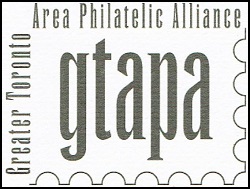
www.gtapa.org
The GTAPA is committed to promote and stimulate the art of philately
to all ages for fun, culture, education, and friendship.




